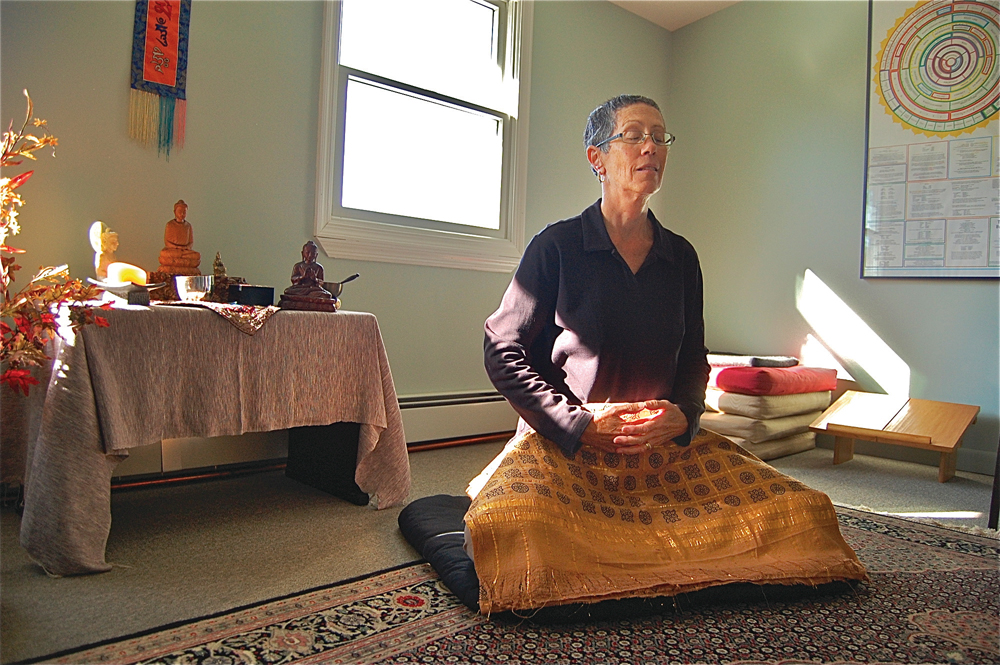Here’s how you can become more mindful with meditation

Until recently, whenever I heard the word “meditation” I immediately pictured a New Age guru with a soothing voice telling me to close my eyes and imagine myself on a tropical island, breathing in the sultry air.
After all, that’s how the ancient Eastern practice — which the National Center for Complementary and Integrative Health says has been shown to help anxiety and depression and reduce blood pressure — seems to be portrayed in film and literature.
Still, I had long suspected this was just an unfortunate stereotype, so I was eager to discuss the ins and outs of the calming technique with Charmaine Henderson, a retired attorney who has been teaching meditation weekly at her Cutchogue home for the past two months.
Every Tuesday from 6:30 to 8:30 p.m., Ms. Henderson leads participants in a practice called insight meditation, which she said focuses on mindfulness.
“Mindfulness is this capacity to observe, to know what’s happening to us and within us, as much as possible moment by moment,” she explained. “And not believing or fixating on any judging thoughts that arise, or comparing thoughts … It’s really this open, non-judgmental awareness.”
During the two-hour sessions, participants practice meditating while sitting, during which they focus on their breathing, listen to the sounds around them and let thoughts wash over them. They then engage in walking meditation, which Ms. Henderson said offers a different type of sensory experience.
“The focus is on the sensation of walking,” she said. “It can be done slowly, so that there’s an observation of lifting the foot and then placing it.”
Here are some excerpts from the rest of our conversation. Note: Some answers have been edited for clarity and length.
Q: How long have you been practicing meditation?
A: I started to practice in 1994. I had sort of been intrigued and interested and read and gone to an introductory lecture, but I really began to practice when I went to the Insight Meditation Society in Barre, Mass., for a nine-day silent residential retreat.
Q: Wow, a silent retreat? What was that like?
A: For me, at that time, it felt like coming home. It really felt very supportive. It was scary, as well, to have that experience of not speaking. It included not reading, as well. It really was to sort of help create this way of looking internally.
Q: Was there something specific that spurred your interest in meditation?
A: For me, it was this sense of dissatisfaction. I also had experiences of anxiety and tended to worry.
Q: Who is meditation particularly beneficial for?
A: In my experience, I think anyone can benefit. It can be helpful for anxiety and depression. In fact, there are a number of therapies, from what I understand, that have sort of evolved [from it]. There’s mindfulness-based cognitive behavioral therapy, for example.
Q: What do you think one of the biggest misconceptions about meditation is?
A: Certainly one of the major ones is that to meditate you have to stop thinking. [Laughs] As though we could stop thinking! Just as the heart pumps blood and the lungs breathe, the mind thinks … People think they’re going to “zen out.” I also think some people think it’s going to be an instant fix, whereas it definitely is a process. And it usually takes a while for people to be able to sit regularly, even five or 10 minutes a day.
For more information about Ms. Henderson’s meditation classes, email her at [email protected].
Have a health column idea for Rachel Young? Email her at [email protected].
Photo caption: Charmaine Henderson meditating in her Cutchogue home. (Credit: Rachel Young)







